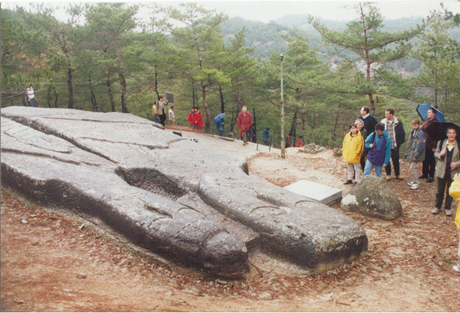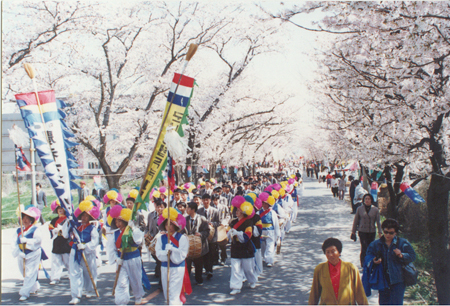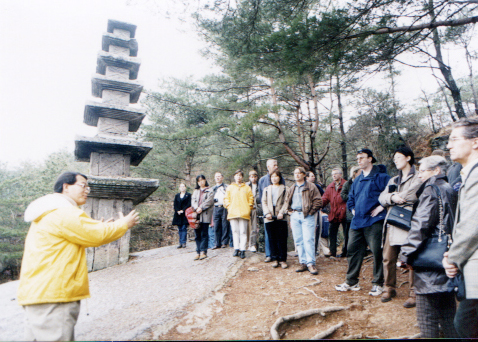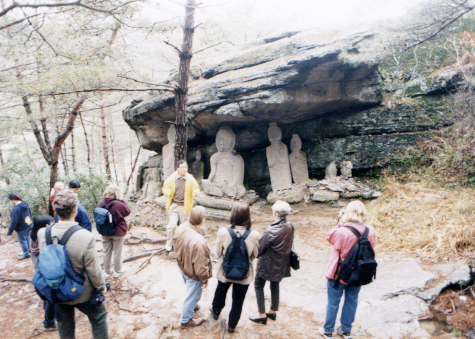 Neglected
charms of South Cholla Province; Cherry Blossom Festival
celebrates achievements of scholar Wangin Neglected
charms of South Cholla Province; Cherry Blossom Festival
celebrates achievements of scholar Wangin
KURIM,
South Cholla Province ? Foreign residents of Seoul might
find a journey to South Cholla Province a bit like traveling
to a different country.
Excluded from South Korea's breakneck
industrial development in the 1970s, the region features
breathtaking views of mountains against the backdrop
of the sea.
Dozens of North American and European
tourists made this discovery last weekend as they walked
through the tree-lined streets of Kurim, Yongam County,
on their way to the annual Wangin Festival, an event
commemorating a legendary 4th century scholar from the
area. As blossoms fluttered overhead in an afternoon
breeze, tour guide Moon Gwan-ho explained that the area's
unspoiled beauty is one positive legacy of years of
exclusion.
 Once the seat of Korea's
ancient Paekche Kingdom (38 B.C.-660), southwestern
Korea's troubles began in the 15th century, after local
Confucian scholars found themselves on the losing end
of a regional power struggle. More recently, the Cholla
provinces suffered discrimination at the hands of political
leaders who hailed from the country's southeast. Once the seat of Korea's
ancient Paekche Kingdom (38 B.C.-660), southwestern
Korea's troubles began in the 15th century, after local
Confucian scholars found themselves on the losing end
of a regional power struggle. More recently, the Cholla
provinces suffered discrimination at the hands of political
leaders who hailed from the country's southeast.
The four-year-old Wangin Festival
is part of an effort to call attention to the region's
neglected attractions. Developed around an existing
springtime event, the annual Cherry Blossom Festival,
the event celebrates the achievements of Dr. Wangin,
a scholar of the Paekche Kingdom who introduced the
rudiments of Chinese culture to Japan in the 4th century.
Not many artifacts of the scholar
survive in his homeland ? few, in fact, beyond the mountain
cave he used as a study before entering Japanese lore
as "Dr. Wani." But a good deal is known of
his role as a royal emissary of the Paekche court who
shared his learning with the nobles of Japan's ancient
Asuka culture. Dr. Wangin took with him not only the
complete works of Confucius and 1,000 Chinese characters,
but also hundreds of Korean artisans skilled at producing
paper, ceramics and textiles.
 Sadly, this year's festival
offered fewer attractions than in the past, thanks to
a previous night of bad weather. Previous festivals
have included performances of regional farmers' music,
exhibitions of folk crafts and a 60-minute parade commemorating
Dr. Wangin's arrival in Japan. Fortunately, the storm
ushered in sunny weather last Saturday that drew thousands
of attendants. While the omissions in this year's program
were disappointing, visitors had a chance to enjoy a
relaxed atmosphere while sampling some of the region's
renowned cuisine. Sadly, this year's festival
offered fewer attractions than in the past, thanks to
a previous night of bad weather. Previous festivals
have included performances of regional farmers' music,
exhibitions of folk crafts and a 60-minute parade commemorating
Dr. Wangin's arrival in Japan. Fortunately, the storm
ushered in sunny weather last Saturday that drew thousands
of attendants. While the omissions in this year's program
were disappointing, visitors had a chance to enjoy a
relaxed atmosphere while sampling some of the region's
renowned cuisine.
The people of the region showed a
polite curiosity in foreign guests from countries such
as the United States, Germany, France and Sweden.
"It's the non-commercial element of this region
that is appealing," said Jamie Conway, an officer
with the 2nd Infantry Division in Uijongbu. "In
the countryside, people take the time to show their
culture in a personal way. You find a purity in the
people and the culture here." Earlier in the day,
the group gained insights into the region's character
during a visit to Unju Temple, one of Korea's most unusual
cultural sites. It has also been among the most neglected.
Nestled at the base of Mt. Chontae in the province's
Hwasun County, the site captured little attention until
1980, when a devout Buddhist led a one-woman preservation
campaign.
Outraged to find that the site was
overgrown and falling into ruin, Kim Ka-mae gathered
donations for what turned out to be a 1 billion-won
restoration project. Today, Unju Temple is popularly
known as the "Valley of 1,000 Buddhas" because
of the weathered stone images scattered throughout the
site.
 While the number is actually
closer to 70, local legend has it that 1,000 were originally
erected to protect Korea from external invasions in
the 9th century. While the number is actually
closer to 70, local legend has it that 1,000 were originally
erected to protect Korea from external invasions in
the 9th century.
As he led the group along rugged footpaths
to the rim of the valley, tour guide Lee Jun-tak discussed
another aspect of the temple's significance. "While
most temples in Korea were state-sponsored, this one
was seemingly built as an expression of faith by common
people," he said. "You'll notice the craftsmanship
is a bit crude, which suggests these statues and pagodas
were built by people from local farming communities."
It is one of many theories. Other accounts attribute
the landmarks to a renegade official of the Shilla Kingdom
(37 B.C.-935 ) or aristocrats of the Koryo Kingdom (918-1392
). Lee's theory seems the most satisfying, however,
since the site appears to be an expression of simple
faith. The "Valley of 1,000 Buddhas" is dominated
by whimsical pagodas, many built of cylindrical stone
slabs and most deviating from the standard three-tier
format. But nowhere is the curious blend of Buddhism
and folk religion more evident than in the so-called
"Supine Buddhas," statues carved of granite
that rest on an adjoining hilltop. The pair includes
a male and female Buddha, an oddity never fully explained.
Lee recounted a popular legend indicating
that the builders believed that when the supine Buddhas
stood erect, the capital of Korea would be moved to
this spot and world peace would ensue. Efforts to assist
the stone couple in this endeavor have failed repeatedly
over the centuries. Like many of South Cholla Province's
cultural sites, Unju Temple has been spared the commercialization
seen in other parts of the country. So, don't anticipate
the approach of vendors selling imitation traditional
pipes or cheap reproductions of Hahoe masks. "Visiting
this site was almost like being let in on a secret,"
said Ian McGillifrey, a Canadian animator working in
Seoul. "I mean, it wasn't opened to the world until
1980. And the whole presentation was very genuine."
For the remainder of the group's time in the province,
its itinerary included a trip to scenic Mt. Mandduk,
Borum Temple, one of Korea's oldest centers of Zen Buddhism,
and the Kangjin County Koryo Celadon Kiln Site, where
quality reproductions of classic porcelain pieces can
be bought at reasonable prices. South Cholla Province's
low profile in the local tourist industry has unexpected
advantages. Not only are the region's often underrated
sites worth the trip, but it's possible to have them
nearly all to yourself ? at least for the time being.
By Tom Welsh Contributing writer / 1999.04.19 |